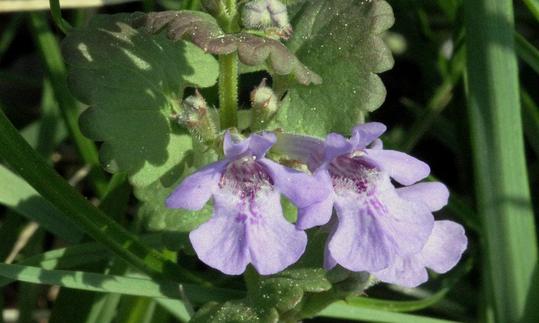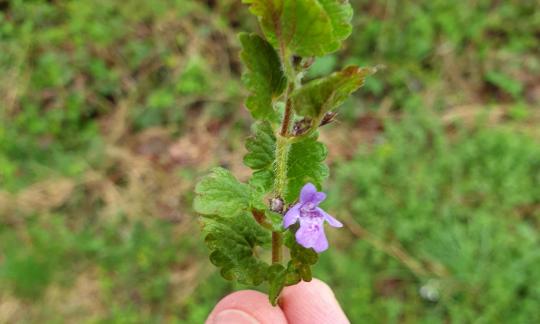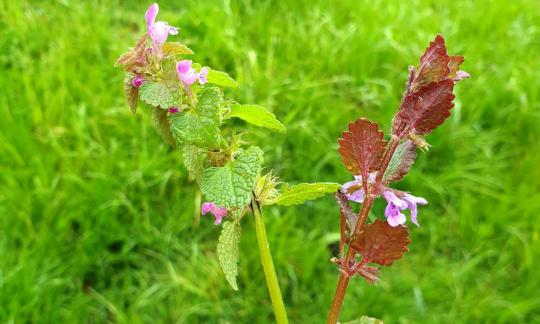Table of contents
Ground ivy ( Glechoma hederacea L.) has been a traditional wild and food plant for many centuries and was used primarily as a medicinal herb in earlier times. Common names include ground ivy, ground ivy and ground ivy. Can be consumed raw or dried, rarely available in organic quality, but from wild collection.
Use in the kitchen
Can you eat ground ivy raw? Is ground ivy edible? This wild-growing and rather inconspicuous food plant is rich in essential oils. For this reason, it should be used in moderation, similar to other herbs. 1
What does ground ivy taste like? Descriptions of the smell and taste range from aromatic to sharp-bitter and slightly scratchy.
What can you do with ground ivy? Fresh or dried ground ivy is used as a kitchen spice, similar to parsley. Because of its thyme-mint aroma, the herb was formerly known as soldier's parsley. Ground ivy can improve the digestibility of food 2 and stimulate the appetite.
From March to May, the tender leaves and shoots can be added to salads, raw soups, stews, chopped herb mixtures, seasonings, Frankfurt green sauce, Maundy Thursday soups, pestos, quark, butter and cream cheese. Ground ivy gives sweet dishes, ice cream and desserts a mint-like note. 1 From May to June, the leaves are particularly suitable as an essential aroma in herbal liqueur, herbal wine, herbal vinegar, herbal oil and drinks, e.g. ground ivy and ground ivy lemonade. 1
The delicately sweet-tasting flowers, which bloom from April to the end of June, can be used in a similar way to the leaves and as an edible decoration on smoothies, desserts and salads. 1
You can get a sweet, delicious crunchy treat by dusting moistened ground ivy leaves with cocoa and icing sugar and drying them slowly in the oven (for raw food, set the oven to 40 °C or use a dehydrator). 1 Or you can dip the fresh leaves in melted dark chocolate and let them dry.
Other wild plants that harmonize with the aroma of ground ivy are young yarrow leaves, chervil leaves (cow chervil), watercress, daisies, nettle leaves and birch leaves. 3
Vegan recipe for Frankfurt green sauce with ground ivy
Ingredients (4 people): 100 g cashews, 100 ml water, 25-30 ml lemon juice (juice of half a lemon), 1 teaspoon mustard, 1 tablespoon rapeseed oil, salt andpepper (to taste). 30 g each of ground ivy, parsley, chervil, tarragon, dill, borage, sorrel and ribwort plantain.
Preparation: Put the cashews and water in a cup and use a hand blender to blend into a cream. Mix the lemon juice with the mustard and rapeseed oil. Wash the herbs under cold running water, shake out the water well and chop very finely on a cutting board using a knife or herb slicer. Mix all the ingredients in a bowl and season with salt and pepper. You can find the original recipe (without ground ivy) HERE.
Warning for borage: Borage contains liver-toxic and carcinogenic pyrrolizidine alkaloids (PA), which is why the Federal Institute for Risk Assessment does not recommend its consumption. To be on the safe side, you can replace the borage with a classic ingredient of the traditional Frankfurt green sauce ( cress, burnet or chives) or alternatively use lemon balm. You can find out more about the PA problem by clicking on the ingredient borage.
Recipe for fresh ground ivy tea
Pour 250 ml of boiling water over 1-2 teaspoons of dried or fresh ground ivy and let the herbs steep for about 10 minutes. Drink one cup daily or twice daily as a cure. 3,4
Vegan recipes with ground ivy can be found under the note: " Recipes that have the most of this ingredient ".
| Not only vegans or vegetarians should read this: Vegans often eat unhealthily. Avoidable nutritional errors. |
Purchasing - Storage
Can you buy ground ivy tea? Ground ivy herb is available dried and loosely packaged online, in pharmacies and drugstores. It is often sold under the name ground ivy tea, ground ivy tea or ground ivy herb. The herb for making tea can also be used as a spice in the kitchen. Rarely with organic certification if the herb comes from wild collections.
Supermarket chains such as Coop, Migros, Denner, Volg, Spar, Aldi, Lidl, Rewe, Edeka, Hofer and Billa as well as the organic supermarkets Denns and Alnatura do not yet carry Gundermann in their product range.
Found in the wild
Where can you find ground ivy? Ground ivy is an indicator plant for moist, heavy, fertile, calcareous and nitrogen-rich soils. It grows on forest edges, in hedges, in alluvial bushes, on farm meadows, in moist forests, on walls, on fallow land, as a weed in gardens, on meadows or on roadsides. 3,5,6
What does ground ivy look like? The fast-growing ground ivy is a rhizome plant with creeping stems. These square stems are up to 200 cm long and root at the nodes. The common name ground ivy is derived from its ivy-like leaves and its ivy-like growth. In the flowering regions, the plant stands up to about 20 cm tall. The notched, kidney-shaped leaves are arranged opposite each other. The leaves, which are up to three centimeters wide, are clearly streaked with prominent leaf veins and sometimes have a reddish tint. The flowers are lip-shaped, one to two centimeters long and blue, blue-violet to pink-violet in color. When crushed, the above-ground parts of the plant have a strong ethereal scent. 6
When does ground ivy bloom? The main flowering period is from early April to late June. 1 The flowers are light purple with a dark spot on the lower lip. 3
When do you harvest ground ivy? The traditional season for harvesting the leaves is in spring to early summer, from March to the end of June, or during the flowering period. 1,4 However, studies show that the content of secondary plant substances is higher after flowering. We therefore recommend harvesting ground ivy between July and September. The vegetative shoots are also particularly valuable and can be harvested several times between May and September. 18
Storage tips
Ground ivy should be used fresh, frozen or gently dried. To do this, you can spread it out on a kitchen towel and leave it to dry in the fresh air. The plant parts should not be exposed to direct sunlight. If the plant parts rustle when you touch them, they are dry and you can chop them up with scissors. Paper bags, metal cans or brown jars are suitable for storage. 7
Ingredients – Nutritional values – Calories
Fresh ground ivy contains up to 10% (or more) tannins, while dried herbs contain 3-7%. Other ingredients include bitter substances, vitamin C and minerals (especially potassium). 1,3,8,9 They also contain polyunsaturated fatty acids. 21
The ground ivy contains 0.03-0.1% essential oil with the main components pinocarvone, menthone and pulegone. 16
You can find all the ingredients of Gundermann, the coverage of the daily requirement and comparison values with other ingredients in our nutrient tables. In the article Nutrients explained you will get a detailed insight into the topic.
Effects on health
Is ground ivy healthy? As a fresh or dried spice or as a tea, ground ivy supports health thanks to essential oils and secondary plant substances and is an ideal addition to a plant-based diet.
Extracts from ground ivy have an antioxidant effect. Therefore, possible use as a natural food additive for the food industry is being investigated. 17 The antioxidant effect is also important for human health, as it reduces oxidative stress, which can cause various diseases, including cardiovascular diseases and cancer. Oxidative stress is caused by excessive production of reactive oxygen species (ROS), which results in DNA damage, lipid peroxidation and oxidation of proteins (carbonyl proteins). An in vitro study from 2023 found that ground ivy extracts can protect human cells from DNA damage, suppress protein oxidation and reduce lipid peroxidation through their antioxidant effect. This could help maintain health. 20
Pouring hot water over ground ground ivy has antibacterial, insecticidal and platelet-stimulating effects. It has been proven to have anti-inflammatory effects several times, but no anti-cancer effects have been found. 21,22
Some uses of ground ivy are known from folk medicine. The herb's ascribed wound-healing, diuretic (promotes urine excretion) and ulcer-protective properties probably come from the tannins it contains, which have an astringent effect. 16
Secondary plant substances
Many of the health effects of Gudermann (Gundelreben) can be attributed to the secondary plant substances it contains. Our article on secondary plant substances provides an overview of the classification of substance groups, their occurrence in foods and possible effects on humans.
Several polyphenols have been detected, such as chlorogenic acid, phenolcarboxylic acids (rosmarinic acid, caffeic acid, ferulic acid), flavonoids (apigenin, luteolin, quercetin), sesquiterpenes (glechomafuran, glechomanolide), triterpenecarboxylic acids (ursolic acid, oleanolic acid) and hydroxy fatty acids. 1,3,8,9 In addition, rutin, genistin, genistein, 21 choline, saponins and essential oils (up to 0.06% in the dried herb). 1,3,8,9
Ground ivy contains several secondary plant substances with antioxidant effects, with flavonoids such as luteolin and quercetagin being present in large quantities. 17
However, it should be noted that the composition of secondary plant substances in ground ivy can vary depending on the variety, time of harvest and growing conditions. Therefore, quantities are only of limited use and should only be understood roughly.
Dangers - Intolerances - Side effects
Is ground ivy poisonous? There are no known cases of poisoning in humans. 9 However, you should not overdose on ground ivy. You should avoid using it in larger quantities as a spice, as the plant contains a lot of essential oils. 1-2 teaspoons of dried or fresh ground ivy is enough to make tea or season food. 1,3
Consumption of large amounts may result in gastroenteritis, intestinal colic and diarrhea. No interactions or contraindications known. 16
Risk of confusion
Is there a risk of confusion with ground ivy (Gundermann)? Similar, but non-toxic medicinal and wild plants are bugleweed, small self-heal or red deadnettle. The flowering time and a close look at the leaves, flowers and growth form can be helpful clues. 7
Because of its name, ground ivy should not be confused with common ivy ( Hedera helix). This can be poisonous even if it comes into contact with the skin. The ivy's fruits are particularly toxic and eating a few berries can lead to serious poisoning. 8 Common ivy looks very different from ground ivy in terms of its leaves and flowers.
Folk medicine - natural medicine
Ground ivy is not a recognized medicinal plant. Ground ivy is used exclusively in folk medicine. The herb is used and is harvested when it is in bloom. The drug name for this is Hederae terrestris herba. 16
However, the ingredients do not rule out effectiveness. The slight irritant effect of ground ivy (and other medicinal plants) stimulates the metabolism and increases the activity of almost all organs in the body. 1,3
Indications include gastric and intestinal catarrh, stomach upset with diarrhea, bladder problems, flu-like infections, loss of appetite, cough with thick mucus, jaundice, and gallbladder, liver and kidney problems. Ground ivy is traditionally used for the symptomatic treatment of stubborn skin inflammations, festering pimples (acne), and for rinsing and gargling in cases of inflammation in the mouth and throat. 1,3,9,10 The fresh plant is preferable because it contains more tannins than dried herbs.
Ecological footprint - animal welfare
The CO2 footprint is primarily used to assess the climate friendliness of a food product. This depends on various aspects, such as cultivation method (conventional/organic), seasonality, country of origin, processing, transport and, if applicable, packaging. We have not found any values for the CO2 footprint of Gundelmann (Gundelreben).
For detailed explanations of various sustainability indicators (such as ecological footprint, CO2 footprint, water footprint), see our article: What does the ecological footprint mean?
Animal protection - species protection
Ground ivy is one of the most important spring flowers for wild bees in Central Europe. Pollination is usually carried out by bumblebees and fur bees. Other frequent visitors to the so-called ground ivy include hoverflies, woolly hoverflies, beetles, ants and some butterflies such as the Aurora butterfly, the Brimstone butterfly and the Rapeseed white butterfly. 6
Since the flowering period is from April to June, the ground ivy is referred to as an early summer nectar. Nectar is the general term for the food that the bees bring in, i.e. nectar, pollen and honeydew. The nectar value of the ground ivy is medium and the pollen value is low. 6
Worldwide distribution - cultivation
Ground ivy is native to Eurasia, but is also found in Canada, the USA and northern Mexico. 19 In Europe it is a common and widespread herb. 3,6 It is found in China, Korea and Japan, as well as in the Caucasus and Siberia. 20
Although studies have shown the commercial potential of ground ivy, ground ivy is only collected from wild stocks. Commercial varieties are not available. The domestication of well-adapted populations with a good spectrum of secondary plant substances would be necessary so that the processing industry would have stable, high-quality raw materials available and the wild stocks would be protected. Studies show that ground ivy cultivated organically from wild stocks had similar chemical compositions of the bioactive substances to the wild plants in the second year. 18
Growing your own
In late summer, you can sow ground ivy seeds from specialist retailers; pre-grown seedlings can be planted out in spring. The easiest way to grow ground ivy is by cutting. The ground ivy, which takes root quickly, forms many runners that grow into a dense, flat carpet. The plant is ideal for slopes, as it protects soil from erosion, as well as for balcony boxes and as a pot plant. 11
Ground ivy grows like a weed and can steal light and nutrients from other plants. It is therefore a good idea to regularly cut off the long tendrils and their potential offshoots. Ground ivy is also very susceptible to fungal infections. To prevent infected weeds from infecting surrounding plants, the mother plant should be pulled out, including roots and runners. 12,13
Further information
Ground ivy ( Glechoma hederacea) is a plant species from the mint family (Lamiaceae). The genus Glechoma includes about 12 species of creeping perennials. 4
The insecticide Gleheda was found in the leaves of ground ivy. 21
Alternative names
The common people know numerous names for ground ivy, including real ground ivy, ground ivy, soldier's parsley, hedge kieker, blue huder, gundam, earth wreath, buldermann, thunder vine, hederich, ground ivy, gundelrieme, huder, little goat's herb, silver herb, gunelreif, healing ivy, udrang and little goat's herb.
The English name is ground ivy. There are also some alternative names for ground ivy in English: creeping Jenny, ground ivy, gill-over-the-ground, alehoof, catsfoot, hedgemaids, creeping Charlie, field balm, run-away-robin, tunhoof, tun-hoof, gill-go-by-the-hedge, lizzy-run-up-the-hedge and robin-run-in-the-hedge.
Bibliography - 20 Sources (Link to the evidence)
| 1. | Fleischhauer, S. G., Guthmann, J., Spiegelberger, R. Enzyklopädie. Essbare Wildpflanzen. 2000 Pflanzen Mitteleuropas. 1. Auflage: Aarau: AT Verlag; 2013. |
| 2. | ugb.de (Unabhängige Gesundheitsberatung) Kräuter: Wildes aus der Natur. |
| 3. | Pahlow, M. Das grosse Buch der Heilpflanzen. Gesund durch die Heilkräfte der Natur. 8. Auflage. Hamburg; 2019. Nikol Verlagsgesellschaft mbH & Co. KG. |
| 4. | Bown, D. Kräuter. Die grosse Enzyklopädie. Anbau und Verwendung. 2. Auflage. München; 2015. Dorling Kindersly. |
| 5. | InfoFlora.ch Glechoma Hederacea L. Gundelrebe. |
| 6. | Kremer, Bruno P. Mein Garten – Ein Bienenparadies. 2. Auflage. Bern; 2018. Haupt Verlag. |
| 7. | kostbarenatur.net Kräuter richtig trocknen und das ganze Jahr über verwenden. |
| 8. | awl.ch Gundermann, Gundelrebe – Glechoma hederacea. |
| 9. | Goethe Universität, Frankfurt am Main. Arzneipflanzengarten. Gundelrebe. |
| 10. | Gerhard I, von Ganski N. Die neue Pflanzenheilkunde für Frauen. 1. Auflage. München;2011. Verlag Zabert Sandmann GmbH. |
| 11. | kräuter-buch.de Gundermann. |
| 12. | gartenjournal.net Welche Verwendung gibt es für Gundermann? |
| 13. | gartenjournal.net Gundermann oder Gundelrebe wirksam bekämpfen. |
| 16. | Bäumler S. Heilpflanzenpraxis - Heute. Arzneipflanzenportraits (3. Auflage). München: Urban & Fischer; 2021: 284-286. |
| 17. | Milovanovic M, Zivkovic D, Vucelic-Radovic B. Antioxidant effects of Glechoma hederacea as a food additive. Nat Prod Commun. 2010;5(1):61-63. |
| 18. | Sile I, Krizhanovska V et al. Wild-Grown and Cultivated Glechoma hederacea L.: Chemical Composition and Potential for Cultivation in Organic Farming Conditions. Plants. 2022;11(6):819. |
| 19. | Waggy MA. Glechoma hederacea. USDA Fire Effects Information System (FEIS). 2009. |
| 20. | Sławińska N, Kluska M et al. New Aspect of Composition and Biological Properties of Glechoma hederacea L. Herb: Detailed Phytochemical Analysis and Evaluation of Antioxidant, Anticoagulant Activity and Toxicity in Selected Human Cells and Plasma In Vitro. Nutrients. 2023;15(7):1671. |
| 21. | Uritu CM, Mihai CT et al. Medicinal Plants of the Family Lamiaceae in Pain Therapy: A Review. Pain Res Manag. 2018;2018:7801543. |
| 22. | Grabowska K, Amanowicz K et al. Optimization of the Extraction Procedure for the Phenolic-Rich Glechoma hederacea L. Herb and Evaluation of Its Cytotoxic and Antioxidant Potential. Plants. 2022;11(17):2217. |









Comments